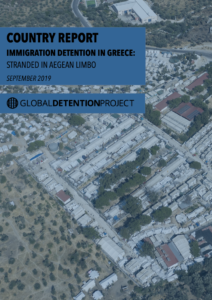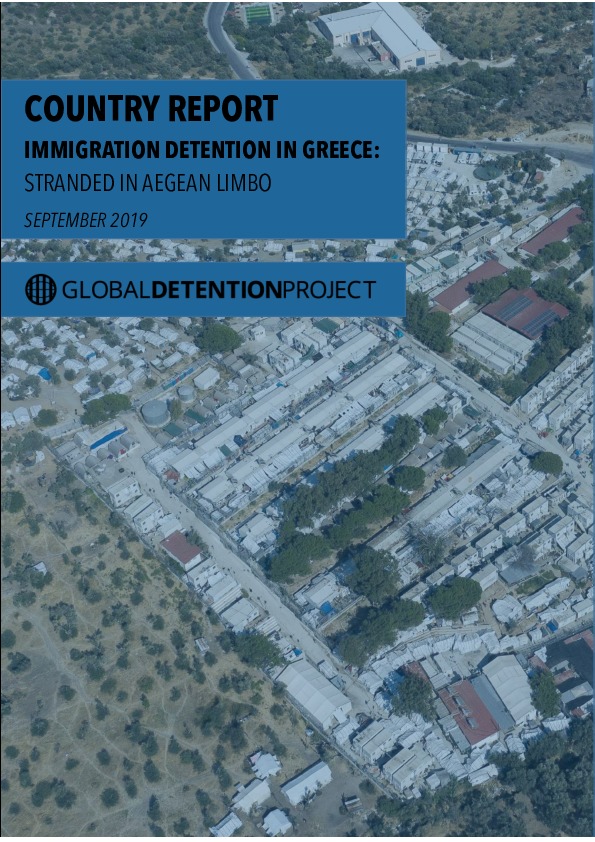Immigration Detention in Greece (2019 Report): A critical entry point for migrants, refugees, and asylum seekers into the EU, Greece has been a key focus in Europe’s efforts to halt refugee flows. Since the EU-Turkey agreement in 2016, a policy of geographical restriction has left large numbers of people stranded on the Aegean islands for months in conditions that observers have denounced as appalling and verging on a humanitarian catastrophe. The country’s immigration detention practices have been repeatedly condemned, including the detention of children in facilities that are unequipped to provide for their needs, the lack of individualised assessment, the use of police stations for immigration detention purposes, and conditions across much of its detention estate that amount to inhuman and degrading treatment. Read the Greece Immigration Detention Profile.

Introduction to the 2019 Report
Greece is an important gateway into the European Union for migrants, asylum seekers, and refugees. This has spurred the EU to devise numerous strategies over the years for blocking flows into and out of Greece—particularly in the wake of the refugee “crisis” in 2015—in addition to placing considerable pressure on the country to ramp up controversial detention practices. While some of these efforts have diverted migration flows to other parts of the Mediterranean, these results are often only temporary. In mid-2019, arrivals to the Greek islands again began to surge, spurring the government to propose a slate of controversial measures, including limiting asylum appeals to help speed up returns to Turkey as part of the EU-Turkey deal (discussed below).
Among the more notable aspects of Greece’s control efforts are the “hotspot” reception facilities located on the Aegean islands, which include the participation of EU agencies like Frontex and the European Asylum Support Office (EASO), as well as NGOs and international organisations. Aid workers have described the conditions in these “camps” as calamitous. A mid-2019 account Médecins Sans Frontières aid workers working in these centres reported: “At least 24,000 men, women and children trapped in vastly overcrowded Aegean island camps are being subjected to conditions so harrowing they bear all the hallmarks of humanitarian catastrophe.”
When the numbers of arrivals in the EU rose dramatically in 2015—spurred by the civil war in Syria as well as instability in other countries—Greece received the largest proportion of asylum seekers in the EU. Of the approximately one million people to arrive in the EU in 2015, more than 850,000 entered via Greece. To stem arrivals, the EU reached an agreement with Ankara to counter immigration pressures. Under the March 2016 EU-Turkey deal, it was agreed that all migrants and asylum seekers who arrived on the Greek islands after 20 March 2016 could be returned to Turkey. For every migrant or asylum seeker sent back to Turkey, the EU would resettle one Syrian from Turkey. Turkey was also promised six billion EUR to assist the refugee community in the country, the granting of visa-free travel for Turkish citizens, and the resumption of Turkey’s EU accession process. The EU justified the return of migrants and asylum seekers to Turkey on the basis of the “safe third country” principle. However, it was patently clear from the outset that Turkey would not fulfil the criteria to be considered a safe haven. The EU-Turkey deal eventually diverted flows to Italy and in 2016 arrivals to Greece dropped to 170,000.
To implement the EU-Turkey agreement, Greece converted reception centres on five Aegean Islands into closed (or “secure”) facilities and adopted a policy of “geographical restriction.” Pursuant to this measure, authorities ceased transferring migrants and asylum seekers to the Greek mainland, forcing them to remain on the island on which they have been registered and undergo a fast-track border procedure. Administrative delays, however, have left thousands migrants and asylum seekers stranded on the Aegean islands for months or even years. Numerous reports have denounced appalling conditions in the centres, including severe overcrowding, insufficient food supply and medical care, and a lack of protection from violence.
Greece’s immigration detention practices long spurred concerns and criticisms, including: its resistance to using non-custodial “alternatives to detention”; its systematic detention of children; the issuing of detention orders that lack individual assessments; inadequate conditions of detention; and the use of police stations for immigration detention purposes. Greece’s detention system has attracted broad international condemnation—including from four UN Special Procedures and four UN human rights treaty bodies. The European Committee for the Prevention of Torture (CPT) has also visited detention facilities on several occasions and the country’s policies prompted more than 20 rulings by the European Court of Human Rights (ECtHR).



